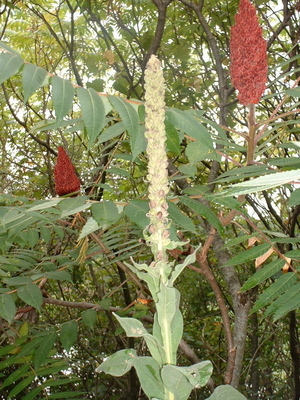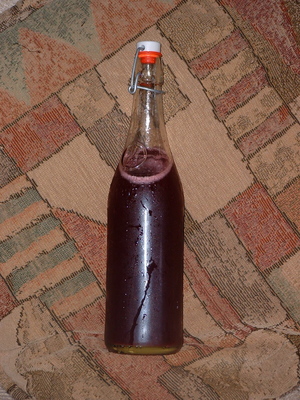Wildcrafting - Staghorn Sumac soda

Staghorn Sumac in fruit, framing a second year mullein plaint in flower.
Linda Diane Feldt | Contributor
I published an alternate recipe for this drink last summer. This is a bit simpler, and I was surprised to discover there are a few stands of staghorn sumac that still have tasty berries that can be used. But as is noted at the end, you can also use juice, ginger infusion, or other drinks to make this carbonated beverage.
My foraging friend has many more years of experience than I do with making wine and other fermented beverages. He made this soda a week ago, and I was surprised at the robust flavor and how well the sumac taste did, since we picked it in January! By the time I tasted it it had a slight alcoholic tinge to it. That can happen. I tried a similar recipe with blueberry juice I made, and when it failed I set it aside to deal with later. By the time I had gotten back to it I had made a fruity wine that was actually very pleasant. The crossover from juice to soda to wine and then vinegar is interesting, and you don't always end up with what you expected.
I asked my friend to share his recipe.

This is the type of bottle that is perfect for making home made soda, able to withstand the pressure, and with an easy to remove cap.
Linda Diane Feldt | Contributor
For one bottle (multiply for your bottles, or for one larger bottle)
In a bowl, combine:
1 1/2 C room temperature tap water
About half a head of sumac
Gently knead for a minute.
Strain out the berries and hairs and dead bugs.
Add and blend
1/4 C sugar or other sweetener.
Taste it. It should taste like a nice refreshing sample of lemonade. Adjust ingredients to your liking. This is sumacade and is delicious as is.
To turn sumacade into sumac soda: Add 1/4 tsp bread yeast, and allow to sit for a few minutes for the yeast to dissolve and activate. Stir.
Pour the sumacade into the bail bottle. Seal. Let it sit at room temperature for a day or two. Gently lift the bail slightly. There should be good pressure. If so, refrigerate and enjoy!
Open gently over a small bowl. They sometimes froth exuberantly.
Substitute lemon, lime, black raspberry, ginger root (steep an infusion, then strain) or other flavors.
*****
Thanks to my foraging friend!
Other recipes I encountered on the internet called for boiling the juice for 20-30 minutes before sweetening and then cooling before adding the yeast. I assume this is a sort of pasteurization so that there are no wild strains of yeast or bacteria. I like the wild card of adding possible wild yeasts, so I don't heat it. And sumac tastes far better made cold, the heat makes it bitter and with an off taste. It is a controversial subject. Should we be pasteurizing everything including milk and almonds, juice and cider? The important thing is that we have the choice.
If you want to make ginger soda, simmer about two inches of chopped ginger root in a quart of water, with a lid. Add about 1/4 cup sweetener, more or less to taste. Once it is cool follow the above directions.
Linda Diane Feldt is a Holistic Health Practitioner, writer and teacher now in her 30th year of private practice. You can follow her on twitter.com/wildcrafting or at www.holisticwisdom.org


Comments
Linda Diane Feldt
Mon, Jan 25, 2010 : 4:03 p.m.
Tammy, does that mean this event won't happen again? I was going to attend, but it was too late when I went to sign up. So I made cider in my champion juicer instead. I agree that many commercial products need the protection of pasteurization. Too many chances for problems. But for small farms, or consumer made or direct from farm to consumer food, we really need the option of non-pasteurized foods. It is controversial, and always helpful when we can talk about the issues without a lot of incitement to fear.
Tammy Mayrend
Sat, Jan 23, 2010 : 10:31 a.m.
I loved your comment about having the choice to pasteurize. For the past several years the Washtenaw County Parks & Recreation program has run a cider day where you can press your own apples to make cider, only this past year someone presumably called the event in and reported it for getting unpasteurized cider. Mind you the cider wasn't sold, and everyone pressing their apples knew the consequences, but still... Pasteurization does change the flavor, and I for one like to experiement with the way things have been done. I'll have to try this soda sometime!!! Thanks.
Linda Diane Feldt
Sat, Jan 23, 2010 : 9:53 a.m.
I could have said more about selecting the fruit. Look for bright red berries that have a lemony taste when you lick them. Most of what you will find is old and tasteless, you want a fruit cluster that has preserved some flavor. The old barn red color berries won't have as much flavor. Is sumac poisonous? Not staghorn sumac, and nothing else looks like these fruit clusters around here. Poison Sumac Toxicodendron vernix or Rhus vernix is found in swamps, and has white berries. All parts of the poison sumac can cause a topical reaction similar to poison ivy. If you spend time in swampy areas you need to be able to identify it.